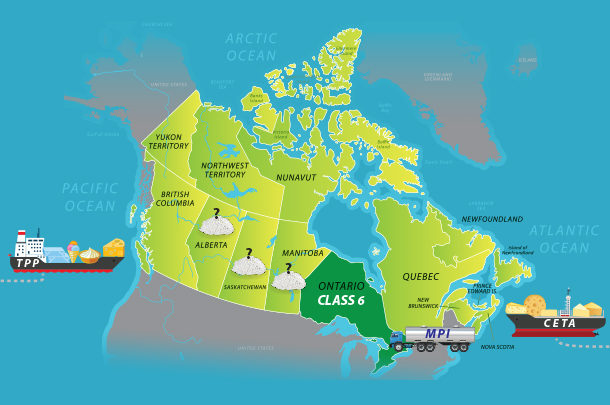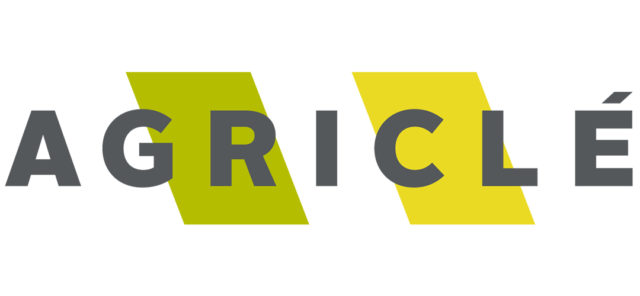1. CETA
The EU-Canada Comprehensive Economic and Trade Agreement (CETA) was agreed upon in October 2013, but it is still working through three important steps before it can be implemented.
The first step is the legal scrub, where trade lawyers put what the negotiators resolved into legal text. This step was completed in February.
The next step is to translate the agreement into every official language in Canada and the EU.
Finally, each individual government involved in the agreement must ratify it.
Gould said the Canadian government is expecting to implement CETA sometime in early 2017, although he estimates it will more likely be in 2018 to allow enough time for translation and ratification.
CETA will allow 17,000 new tonnes of cheese into Canada.
“That is a pretty significant amount,” Gould said. “Our total imports right now are about 20,000 tonnes, so 17,000 on top of that is quite a bit.”
It also represents roughly 2 percent on an all-quota basis of the Canadian market, which he said demand might be able to outgrow as the imports are phased in over five years from the point of implementation.
The imports, which can be cheese of any form from any country in the EU, will be allocated to specific companies through a tariff-rate quota (TRQ).
“Once CETA is implemented, the Europeans will monitor the use of TRQ. If it is not being used, it will be taken away from those companies and given to someone else. They are very determined that full amount will be exported from Europe or imported into Canada,” Gould said.
2. TPP
An agreement was reached for the Trans-Pacific Partnership (TPP) in October 2015. Canada and other participating countries signed it in early 2016. Gould said the legal scrub was done on the fly as the negotiations took place. It also only has three official languages – English, French and Spanish – so translation should be easier than CETA.
TPP’s biggest hurdle is government ratification, as the new liberal government has not clearly indicated its support. Both New Zealand and the U.S. have upcoming elections that may also change the countries’ support of the agreement.
TPP grants a larger amount of Canadian market access at 3.25 percent on an all-quota basis, which will phase in over five years once the agreement is implemented.
“I think the Canadian negotiators did a pretty good job. Under TPP, certainly the Americans, the Australians, the New Zealanders were really out to end supply management. ... Getting away with 3.25 percent, all things considered, is pretty good,” Gould said.
Two-thirds of that 3.25 percent will be in the form of cheese and butter going for further processing. The balance of the imports will be in the full-range of dairy products – fluid milks, creams, yogurt, ice cream, whole milk powder and skim milk powder.
“I think the TRQ enforcement with respect to TPP is going to be what I would call ‘soft,’” he said, explaining the EU wants to make sure every kilogram in CETA is accounted for, but in TPP, the other countries aren’t going to be as interested in filling their new TRQ.
Again, Gould said, growth potential in the Canadian marketplace could shoulder the incoming products, and Canadian producers hopefully won’t see an impact on their quota.
When the previous federal government was negotiating TPP, it made a commitment to provide compensation to offset the effects of CETA and TPP. It offered $3.9 billion to producers over a period of time. It also planned to invest $450 million in innovation and new processing.
“[DFO] sees the critically important need for investment in Ontario and the rest of Canada, and that investment fund is a big part of that. We are doing a lot of lobbying and working with governments both provincially and federally to move that forward,” Gould said.
At the time of this writing, there is no commitment from the new government to follow through on this proposal.
3. Diafiltered milk
Diafiltered milk is just another term for milk protein isolates (MPI). Protein as a portion of total skim milk solids is around 35 percent. If the water or lactose is removed, it results in a higher concentration of protein or something known as a milk protein concentrate (MPC).
When the MPC is filtered a second time, the concentration of milk protein can be much higher, and anything greater than 85 percent protein is known as an MPI. Since the product has been filtered twice, it is now considered an adulterated or a modified milk product and is classified as an ingredient, Gould explained.
While MPCs are regulated in trade, the Canadian International Trade Tribunal (CITT) ruled 10 years ago that MPI is a different product and not subject to tariffs and TRQ, and could legally enter Canada duty free.
A lobbying effort, organized by Dairy Farmers of Canada and supported by the provinces, ended with the government implementing a new tariff and TRQ for MPI. While new tariffs are allowed through WTO, NAFTA does not allow them. This effort capped the quantities coming from New Zealand, Switzerland and a few other countries, but now all of the growth is coming from the U.S.
Gould said, “The frustration is that they cross the border as an ingredient; that’s why they are tariff free. When they are used particularly to make cheese, the CFIA [Canadian Food Inspection Agency], who does the audits, counts them as milk.
“The message is pretty simple if you have components – butterfat and protein – depending on the product, but certainly for cheese, that’s all you need. Milk is not a requirement for virtually any dairy product. Unless we figure out ways to manage or control what’s used and how it’s paid for, the impact on dairy producer incomes and the market in Canada could be quite dramatic.”
One way to limit the use of MPIs is to have the CFIA audit them differently. Instead of having them on the milk side, they become an ingredient, which would limit their use in cheese on the cheese stand.
Gould said the new federal government is very aware of the situation, but may or may not choose to act. The U.S. is watching closely and has stated there will be repercussions if Canada decides to act.
He added that while controlling the influx of MPIs into Canada is important to the dairy industry, it is not the only measure that needs to be taken to grow the industry and create a stable and viable future.
4. Old drying facilities
Another issue facing the Canadian dairy industry is the fact the dryers that process skim milk are showing their age. There are approximately 11 dryers throughout Canada, with the newest dryer at more than 10 years old.
“If you put in new technology today, you can do a lot of different things with skim solids,” Gould said. “That’s what the market is looking for. There is a demand for skim milk powder, but there is also demand for all of the fractions that you can make from skim milk.”
At the same time, the capacity of the dryers has been reached. In order to satisfy the high demand in the cream market, skim milk has been dumped on a regular basis for the past year.
“We need to build for the future,” Gould said. “Whatever we replace probably has to be at least twice as big. We have to do a lot of catch-up to the current market and allow for growth as we go forward.”
According to Gould, processors have yet to make that investment because the right pricing structure and market signals have not been in place.
5. National ingredient strategy
Thus far, the national strategy has been kept extremely confidential, Gould said. At first there were not a lot of developments, but since DFO announced in October that it was moving forward with an ingredient strategy, he said things have picked up in the national arena.
At the moment, it looks a lot like the Ontario strategy. “So much like the Ontario strategy that if they ever reached an agreement at the national level, we could adapt very easily,” he said.
While some industry members are suggesting the country moves forward together, Gould said of DFO, “We’re ready to go April 1; our stance is doing it together will probably take a year, maybe two, and we don’t have that time.”
6. Ontario ingredient strategy
The two main parts of Ontario’s ingredient strategy, which was approved by the DFO board of directors and put into effect on April 1, are the creation of a new ingredient class and to price that class competitively. The idea is to provide a pricing structure that will allow Ontario’s processors to make necessary investments when it comes to these products.
The new Class 6 is a home for all of the various products that can be made from skim milk solids: skim milk powder, skim milk, MPCs – liquid and dry, condensed milk, evaporated milk, etc.
Its competitive price will help these products compete with imports and position them for export opportunities. “That competitive price is based on what’s going on in the world,” he said.
Gould added the new ingredient strategy “will create a new dynamic in the industry where I think we’ll discover opportunities that have been impossible to pursue at the present time. We will also need a growth strategy. If we’re going to build those plants double, we need to be able to put the milk through them.” PD

-
Karen Lee
- Editor
- Progressive Dairyman
- Email Karen Lee
PHOTO: Staff photo.










